I am working on AWS CloudFormation and I created one template in which I asked user to select Environment.
On the basis of selected value I created the resources. User have to select between DEV, QA, PROD, UAT etc. but when I suffix this value to S3 bucket name (-downloads.com) it not allowed because capital letter is not allowed in S3 bucket name.
So I did change in JSON where I use fn::Transform with "Condition":"Lower" but then while creating resources below error occurs.
No transform named 871247504605::String found.. Rollback requested by user.
Below is my CloudFormation JSON
{
"AWSTemplateFormatVersion": "2010-09-09",
"Description": "Provides nesting for required stacks to deploy a full resource of ****",
"Metadata": {
"AWS::CloudFormation::Interface": {
"ParameterGroups": [
{
"Label": {
"default": "Enviroment Selection"
},
"Parameters": [
"selectedEnv"
]
}
],
"ParameterLabels": {
"selectedEnv": {
"default": "Please select Enviroment"
}
}
}
},
"Parameters": {
"selectedEnv": {
"Type": "String",
"Default": "DEV",
"AllowedValues": [
"DEV",
"QA",
"UAT",
"PROD"
]
}
},
"Resources": {
"S3BucketName": {
"Type": "AWS::S3::Bucket",
"Properties": {
"BucketName": {
"Fn::Join": [
"",
[
{
"Fn::Transform": {
"Name": "MyString",
"Parameters": {
"InputString": {
"Ref": "selectedEnv"
},
"Operation": "Lower"
}
}
},
"-deployment.companyname.com"
]
]
},
"PublicAccessBlockConfiguration": {
"BlockPublicAcls": "true",
"BlockPublicPolicy": "true",
"IgnorePublicAcls": "true",
"RestrictPublicBuckets": "true"
},
"Tags": [
{
"Key": "ENV",
"Value": {
"Ref": "selectedEnv"
}
},
{
"Key": "Name",
"Value": {
"Fn::Join": [
"",
[
{
"Ref": "selectedEnv"
},
"deployments"
]
]
}
}
]
},
"Metadata": {
"AWS::CloudFormation::Designer": {
"id": "c81705e6-6c88-4a3d-bc49-80d8736bd88e"
}
}
},
"QueueForIOT": {
"Type": "AWS::SQS::Queue",
"Properties": {
"QueueName": {
"Fn::Join": [
"",
[
{
"Ref": "selectedEnv"
},
"QueueForIOT"
]
]
},
"DelaySeconds": "0",
"MaximumMessageSize": "262144",
"MessageRetentionPeriod": "345600",
"ReceiveMessageWaitTimeSeconds": "20",
"VisibilityTimeout": "30"
},
"Metadata": {
"AWS::CloudFormation::Designer": {
"id": "6484fbb7-a188-4a57-a40e-ba9bd69d4597"
}
}
}
},
"Outputs": {
"Help": {
"Description": "This is description",
"Value": ""
}
}
}
My question is, I want to do lowercase or sometimes uppercase value for S3 bucket or any other resources. How to do this?
Image of template creation error attached.
